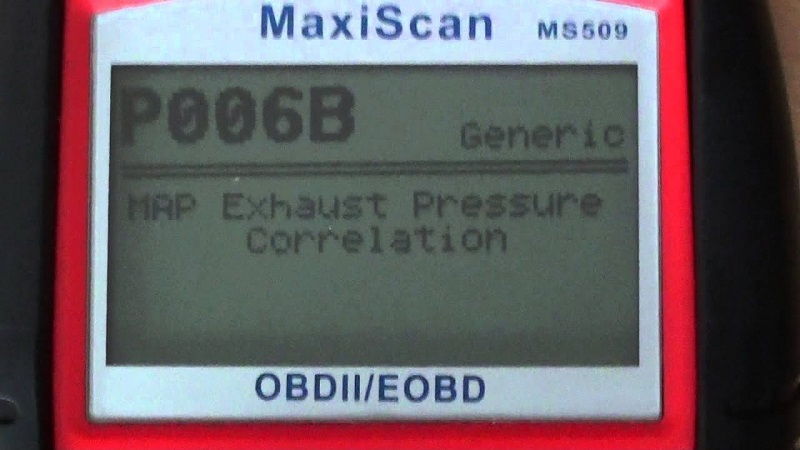This post contains affiliate links. This means I will make a commission at no extra cost to you should you click through and make a purchase [ “As an Amazon Associate, I earn from qualifying purchases.” ]. Read the full disclosure here.
P006B MAP – Exhaust Pressure Correlation GuideMechanic.Com In the realm of automotive diagnostics, deciphering trouble codes can sometimes feel like decoding cryptic messages.
Among these alphanumeric indicators, the P006B code stands out, signaling a potential issue with the correlation between manifold absolute pressure (MAP) and exhaust pressure within a vehicle’s engine system.
Understanding this code and its implications is crucial for drivers and mechanics alike to ensure optimal engine performance and reliability.
See Also: P0069 Code: Manifold Absolute Pressure – Barometric Pressure Correlation
To grasp the significance of the P006B code, it’s essential to first understand the key components involved:
Manifold Absolute Pressure (MAP) Sensor:

The MAP sensor plays a pivotal role in the engine management system by measuring the pressure within the intake manifold.
This data is then utilized by the engine control unit (ECU) to adjust fuel injection timing and optimize engine performance under varying operating conditions.
Exhaust Pressure Sensor:
The exhaust pressure sensor, as the name suggests, monitors the pressure within the exhaust system. This sensor provides valuable feedback to the ECU, aiding in the regulation of exhaust gas recirculation (EGR) and other emissions control functions.
Now, let’s delve into the meaning behind the P006B trouble code:

The P006B code specifically indicates a correlation issue between the readings from the MAP sensor and the exhaust pressure sensor.
In simpler terms, the data collected by these sensors does not align as expected, signaling a potential discrepancy within the engine system. This misalignment can lead to various performance issues and may impact emissions levels.
Several factors could contribute to triggering the P006B trouble code:
Sensor Malfunction:
Like any electronic component, both the MAP sensor and the exhaust pressure sensor are prone to wear and tear over time. Factors such as exposure to heat, vibration, or contaminants can lead to sensor degradation or failure, resulting in inaccurate readings.
Faulty Wiring or Connectors:
Electrical issues such as corroded wires, loose connections, or damaged connectors can disrupt the communication between the sensors and the ECU. This interference can cause erroneous data transmission and trigger the P006B trouble code.
Exhaust System Blockages:
Blockages or restrictions within the exhaust system, such as clogged catalytic converters or particulate filters, can lead to abnormal pressure readings. These obstructions hinder the flow of exhaust gases, affecting the exhaust pressure sensor’s accuracy and triggering the P006B code.
EGR System Malfunction:

Problems within the exhaust gas recirculation (EGR) system, such as stuck valves or clogged passages, can impact exhaust pressure levels. This, in turn, can disrupt the correlation between the MAP and exhaust pressure sensors, leading to the activation of the P006B trouble code.
Engine Mechanical Issues:
Underlying mechanical problems within the engine, such as valve timing issues or exhaust leaks, can indirectly affect exhaust pressure readings. These issues compromise the overall efficiency of the engine system and may trigger the P006B code as a result.
When faced with the P006B trouble code, prompt diagnosis and resolution are essential to prevent further damage and restore optimal engine performance. Here’s a systematic approach to troubleshooting:
Scan for Additional Codes:
Conduct a comprehensive diagnostic scan to check for any additional trouble codes that may offer insight into related issues within the engine system.
Inspect Sensors and Wiring:
Begin by visually inspecting the MAP sensor, exhaust pressure sensor, and their respective wiring and connectors. Look for signs of damage, corrosion, or disconnection that may impair sensor functionality.
Check for Exhaust System Blockages:
Inspect the exhaust system for any signs of blockages or restrictions, paying particular attention to catalytic converters, particulate filters, and EGR components.
Test Sensor Readings:
Utilize a diagnostic scan tool to monitor the real-time readings from both the MAP and exhaust pressure sensors while the engine is running. Compare these readings to specifications provided by the manufacturer to identify any discrepancies.
Perform Component Tests:
Conduct specific tests on individual components, such as the MAP sensor, exhaust pressure sensor, or related circuits, to pinpoint the exact source of the problem.
Address Identified Issues:
Once the culprit is identified, take necessary measures to address the underlying issue. This may involve repairing or replacing faulty sensors, clearing exhaust system blockages, or addressing other mechanical issues.
Clear Codes and Test Drive:
After resolving the problem, clear the trouble codes from the ECU’s memory and take the vehicle for a test drive. Monitor for any recurring issues and ensure that the problem has been successfully resolved.
See Also: P006A MAP – Mass or Volume Air Flow Correlation Bank 1
In conclusion, the P006B MAP – Exhaust Pressure Correlation trouble code serves as a diagnostic indicator of potential discrepancies between the MAP sensor and exhaust pressure sensor readings within the engine system.
While deciphering these codes may pose a challenge, understanding their implications and following a systematic troubleshooting approach is crucial for identifying and resolving underlying issues.
By addressing the root cause promptly, drivers and mechanics can maintain the health and efficiency of the engine system, ensuring optimal performance and minimizing emissions levels.
- Small Food Trucks for Sale - July 6, 2025
- Turnkey Food Trucks for Sale in California - July 6, 2025
- Mobile Food Trucks for Sale in Texas - July 6, 2025
